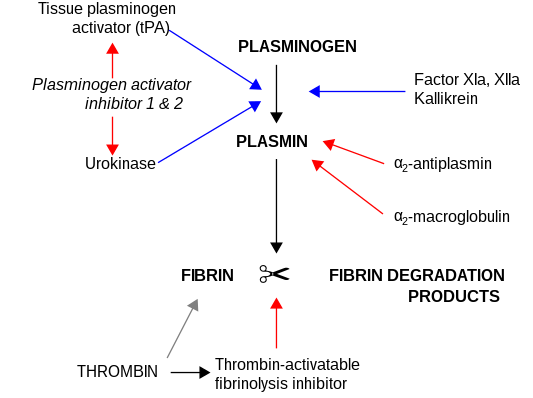The kinin–kallikrein system or simply kinin system is a poorly understood hormonal system with limited available research. It consists of blood proteins that play a role in inflammation, blood pressure control, coagulation and pain. Its important mediators bradykinin and kallidin are vasodilators and act on many cell types. Clinical symptoms include marked weakness, tachycardia, fever, leukocytosis and acceleration of ESR.
Prekallikrein (PK), also known as Fletcher factor, is an 85,000 Mr serine protease that complexes with high-molecular-weight kininogen. PK is the precursor of plasma kallikrein, which is a serine protease that activates kinins. PK is cleaved to produce kallikrein by activated Factor XII.
Kininogens are precursor proteins for kinins, biologically active polypeptides involved in blood coagulation, vasodilation, smooth muscle contraction, inflammatory regulation, and the regulation of the cardiovascular and renal systems.
Renal tissue kallikrein is an enzyme.

Kallikrein-1 is a protein that in humans is encoded by the KLK1 gene. KLK1 is a member of the peptidase S1 family.

Kallikrein-2 is a protein that in humans is encoded by the KLK2 gene, and is particularly associated with prostatic tissue.

Kallikrein-6 is a protein that in humans is encoded by the KLK6 gene. Kallikrein-6 is also referred to as neurosin, protease M, hK6, or zyme. It is a 223 amino acid sequence, derived from its 244 original form, which contains a 16 residue presignal and 5 residue activation peptide.

Kallikrein-10 is a protein that in humans is encoded by the KLK10 gene.
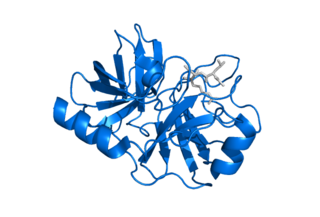
Kallikrein-5, formerly known as stratum corneum tryptic enzyme (SCTE), is a serine protease expressed in the epidermis. In humans it is encoded by the KLK5 gene. This gene is one of the fifteen kallikrein subfamily members located in a cluster on chromosome 19. Its expression is up-regulated by estrogens and progestins. Alternative splicing results in multiple transcript variants encoding the same protein.

Kallikrein-related peptidase 4 is a protein which in humans is encoded by the KLK4 gene.
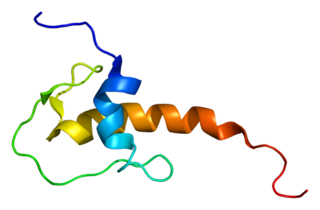
Lympho-epithelial Kazal-type-related inhibitor (LEKTI) also known as serine protease inhibitor Kazal-type 5 (SPINK5) is a protein that in humans is encoded by the SPINK5 gene.

Kallikrein-11 is a protein that in humans is encoded by the KLK11 gene.
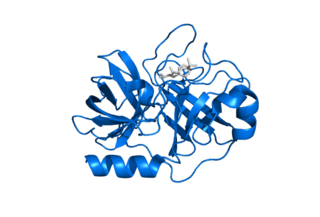
Kallikrein-related peptidase 7 (KLK7) is a serine protease that in humans is encoded by the KLK7 gene. KLK7 was initially purified from the epidermis and characterised as stratum corneum chymotryptic enzyme (SCCE). It was later identified as the seventh member of the human kallikrein family, which includes fifteen homologous serine proteases located on chromosome 19 (19q13).
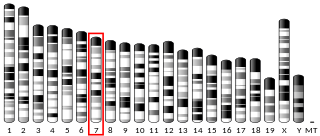
Kallikrein-13 is a protein that in humans is encoded by the KLK13 gene.
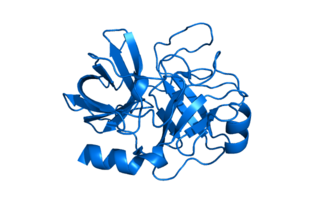
Kallikrein-8 is a protein that in humans is encoded by the KLK8 gene.

Kallikrein-14 is a protein that in humans is encoded by the KLK14 gene.

Kallikrein-15 is a protein that in humans is encoded by the KLK15 gene.

Kallikrein-12 is a protein that in humans is encoded by the KLK12 gene.

Kallikrein-related peptidase 9 also known as KLK9 is an enzyme which in humans is encoded by the KLK9 gene.
Serine protease inhibitor Kazal-type 6 (SPINK6) is a protein encoded by the SPINK6 gene in humans. It is a potent inhibitor of epidermal proteases involved in maintaining skin homeostasis, including KLK5, KLK7 and KLK14. SPINK6 is a member of a gene family cluster located on chromosome 5q33.1, which includes SPINK5 and SPINK9.
